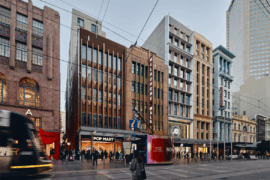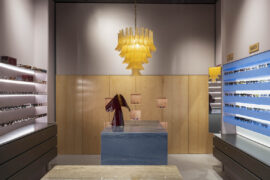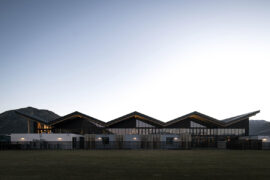Paris-based architecture and interior design practice BOIFFILS Architectures has completed an expansion to the already impressive Changi Airport.

August 16th, 2024
Five years, 120,000 square metres and three levels – that’s the scope of the expansion at Terminal 2, Changi Airport in Singapore. While Safdie Architects completed the renowned Jewel Changi Airport in 2019, this addition to the airport by BOIFFILS has fully redesigned an existing terminal.
Interestingly, however, the team at BOIFFILS weren’t able to know what the Jewel would quite be like when they started working on this project. “Changi’s team was very secretive about it,” explains Basile Boiffils. We finally visited the almost completed construction site about six months after being hired, and most of our design concepts for this T2 project were already designed.”
Boiffils continues: “After this first visit to Jewel, we were extremely impressed and felt a lot of pressure. We felt also some pride when we realised that they selected our team from their next project after this iconic achievement. In fact, our biophilic approach was already there in our proposed scheme at competition stage, and when we discovered the Jewel we thought that our T2 project was going to be a very good match.

The practice has built an international reputation as an architecture and interior design workshop for prestigious retail brands, particularly in the fashion and cosmetics industries before progressing towards larger retail and hospitality projects. Regarding the competition win for Changi, Boiffils expresses joy and surprise: “We finally won this international competition, and for us it was completely unexpected. We were the smallest firm by far in the five teams selected to participate, and we had absolutely no experience in airport design… I believe our background is what made us able to bring a different approach, more oriented towards creating a special traveller’s experience rather than focusing on managing passengers flow. With this approach came a very different architectural language and a different atmosphere.”
For the designers, the relationship between architecture and landscape was at the heart of the project. They were of course also highly conscious of simply how busy the place is.

“Airports are like small cities, with retail, dining, lounges and other services. This project allowed us to bring our ideas to these multifunctional spaces, which require a blend of commercial, hospitality and transportation design skills. Enhancing the passenger experience was a key goal for us. We aimed to create spaces that reduce stress, provide clear wayfinding, and offer amenities that improve comfort and convenience.
“Changi Airport is used by millions of people from around the world, and this project gave us the chance to create solutions that have a global impact and significantly influence the travel experience of countless passengers. It was a thrilling challenge, blending creativity, technical skill and a deep understanding of human behaviour and needs,” says Boiffils.

Originally built in the 1990s and renovated in 2003, the existing terminal architecture was rooted in the traditional airport focus on business efficiency rather than comfort and pleasurable user experiences. BOIFFILS Architectures’ interventions have thus prioritised passenger pleasure and comfort by focusing on a series of visual, auditory and interactive experiences.
The Arrival and Departure halls are key points in the project, while a mezzanine on Level 3 provides food and beverage options. BOIFFILS Architectures have set up an aim of romanticising the airport experience, hoping to offset the stress of travel with stimuli intended to soothe the mind, body and soul.

“Since the terminal opened, we have been delighted to observe that travellers at T2 exhibit a more relaxed attitude, as evidenced by the noticeably lower noise levels compared to other terminals. We attribute this improvement to our design strategy, which prioritised passenger experience and comfort. This was achieved by streamlining all spaces and maintaining a clean, minimal and warm environment through thoughtful material selection and technical choices that limit visual clutter, allowing passengers to focus on what is most important,” explains Boiffils.
He concludes: “At the heart of our work for this project was the desire to humanise the airport experience. A significant part of this effort involved using crafted materials and objects. The walls at T2 are made of handmade stucco panels, and the chandeliers are mouth-blown to our design specifications. This approach contrasts sharply with other airports, where materials are often industrial and off-the-shelf. At T2, everything has been custom-designed to provide a unique and special experience.”
BOIFFILS Architectures
boiffils.com










INDESIGN is on instagram
Follow @indesignlive
A searchable and comprehensive guide for specifying leading products and their suppliers
Keep up to date with the latest and greatest from our industry BFF's!

For a closer look behind the creative process, watch this video interview with Sebastian Nash, where he explores the making of King Living’s textile range – from fibre choices to design intent.

Merging two hotel identities in one landmark development, Hotel Indigo and Holiday Inn Little Collins capture the spirit of Melbourne through Buchan’s narrative-driven design – elevated by GROHE’s signature craftsmanship.

CDK Stone’s Natasha Stengos takes us through its Alexandria Selection Centre, where stone choice becomes a sensory experience – from curated spaces, crafted details and a colour-organised selection floor.

London-based design duo Raw Edges have joined forces with Established & Sons and Tongue & Groove to introduce Wall to Wall – a hand-stained, “living collection” that transforms parquet flooring into a canvas of colour, pattern, and possibility.

A calm, gallery-like boutique by Brahman Perera for One Point Seven Four brings contemporary luxury and craft to Strand Arcade.

Warren and Mahoney’s The Mill in Queenstown blends architecture, wellbeing and landscape, creating a transparent training facility.
The internet never sleeps! Here's the stuff you might have missed

Neill Johanson, Principal at Davenport Campbell, comments on what we might be losing and gaining with the expansion of remote work.

CDK Stone’s Natasha Stengos takes us through its Alexandria Selection Centre, where stone choice becomes a sensory experience – from curated spaces, crafted details and a colour-organised selection floor.

Auckland Design Week returns for its third edition in March, unveiling an expanded programme and a renewed focus on the relationship between people, communities and the places they shape.

BLP’s new Sydney Children’s Hospital, Randwick building brings together paediatric care, family-centred design and Australia’s first Children’s Comprehensive Cancer Centre in a major addition to the Randwick Health & Innovation Precinct.